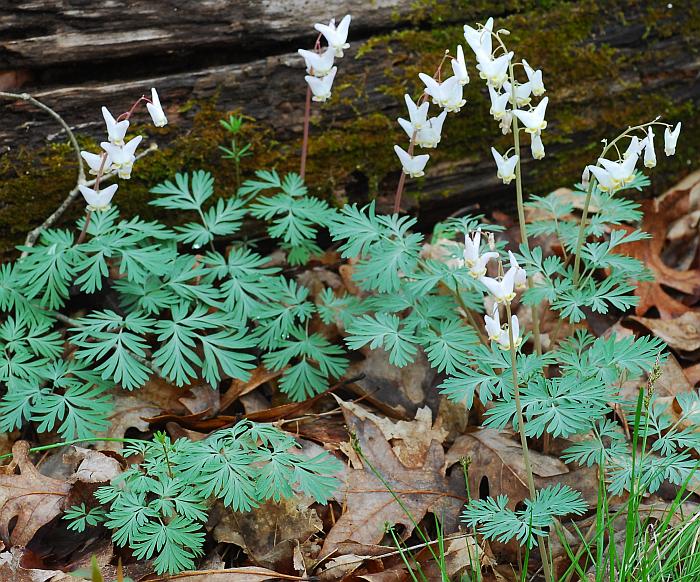Dicentra cucullaria (L.) Bernh.
Dutchman's Breeches

Native
CC = 6
CW = 5
MOC = 81
© SRTurner
Dicentra cucullaria (L.) Bernh.Dutchman's Breeches | |
 |
Native CC = 6 CW = 5 MOC = 81 |
© SRTurner |
|
Family - Fumariaceae Habit - Rhizomatous perennial forb, the rootstock with small bulblets, these teardrop-shaped (asymmetrically ovoid and tapered to a sharply pointed tip), pink or less commonly white.
Stems - Aerial stems absent. Leaves - All basal, long-petiolate, the petiole 8-24 cm long. Blades usually 4 times compound and lobed, 4.5-9.0 cm long, ovate to broadly triangular in outline, the ultimate segments linear to narrowly oblong-elliptic or narrowly oblanceolate, rounded, mucronate, or sharply pointed at the tip, bright green on the upper surface, somewhat paler, not or only slightly glaucous, and sometimes somewhat yellowish green on the undersurface, the ultimate segments angled or tapered to a sharply pointed tip.
Inflorescence - Raceme 10-35 cm long, long-stalked and loosely to densely 3-15-flowered, arching at apex, glabrous. Pedicels to 6-7 mm long, each subtended by a small scalelike bract.
Flowers - Sepals 2-5 mm long, triangular to broadly ovate, attached basally, rounded to more or less truncate base, the margins entire, membranous and white. Outer petals 10-16 mm long, the concave apical portion 2-5 mm long, abruptly spreading to reflexed, yellow to orangish yellow, the remaining portion white or pinkish-tinged, the spurs 3-10 mm long, triangular in outline, angled away from the flower stalk. Inner petals linear or nearly so toward the base, expanded above the midpoint with a broadly winged margin and a well-developed, entire to slightly undulate crest, rounded at the concave tip. Style persistent, relatively slender, the stigma 4-lobed, the lobes appearing as horns and/or wings.
Fruits - Capsules, dehiscent, 5-15 mm long, narrowly ellipsoid, straight, the surface often slightly swollen over the seeds, otherwise smooth, 3-to numerous-seeded. Seeds 1.5-2.5 mm long, somewhat flattened, more or less kidney-shaped in outline, rounded along the rim, the surface smooth or nearly so, black, shiny, the elaiosome an irregular, somewhat conic, white mass attached in the notch.
Flowering - March - May. Habitat - Bottomland forests, ravines, bluff bases and ledges, rich slopes along streams. Origin - Native to the U.S. Lookalikes - D. canadensis. Other info. - This small plant is a popular and well-known member of Missouri's springtime ephemeral flora. It is common in woodlands throughout most of the state, as well as the northeastern quadrant of the continental U.S., and also occurs in areas of the Northwest. It is easily recognized by its lacy leaves and unusual flowers, which do indeed slightly resemble trousers hung out to dry on wash day. Both foliage and leaves are similar to those of the related squirrel corn (D. canadensis), which is much less common in Missouri (though the predominant species in some other regions of the country). D. cucullaria is most easily distinguished by its flowers, which have spreading, bluntly pointed spurs (vs. parallel and rounded spurs in D. canadensis), and by its underground tubers, which are teardrop-shaped and usually pinkish in color (vs. globose and yellow, resembling corn kernels, in D. canadensis). Photographs taken at Eagle Bluffs Conservation Area, Boone County, MO., 3-20-04 and 3-27-04 (DETenaglia); also at Shaw Nature Reserve, Franklin County, MO, 4-9-2006, Washington State Park, Washington County, MO, 4-11-2011, 4-16-2018, and 4-15-2019, along the Katy Trail southeast of Dutzow, Warren County, MO, 4-6-2015, Weldon Spring Conservation Area, St. Charles County, MO, 3-22-2016, Silver Mines Recreation Area, Madison County, MO, 4-8-2019, Little Lost Creek Conservation Area, Warren County, MO, 4-8-2020, and Meramec State Park, Franklin County, MO, 4-16-2020 (SRTurner). |